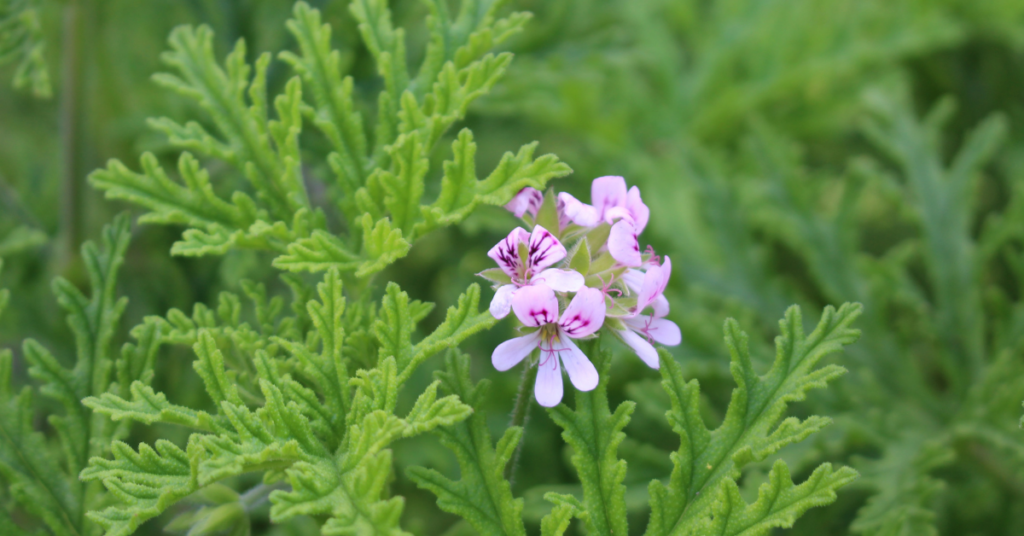Geranium – Essential Oil
Geranium (Pelargonium graveolens)
The geranium plant is a favourite for window boxes, but not all Pelargonium produce oil.
As a balancing oil, it has the ability to relax or stimulate according to your needs. Ancient civilisations saw this plant as a great healer, so great in fact that they believed its oil could heal fractures and even cancers.
Geranium oil is frequently found in skin care products due to its sweet floral perfume. Because of its rose-like scent, geranium oil is often used in products that purport to contain rose oil; the rose oil content may be ‘topped up’ with geranium oil. Indeed, it is sometimes referred to as rose geranium or ‘poor man’s rose’.
Uses include:
Acne
Menopause / pre-menstrual syndrome (PMS) / pre-menstrual tension (PMT)
Cystitis
Mild depression
Diabetes
Fluid retention
Shingles
Caution
Do not use on babies 0-12 months old.
Acne
Geranium oil balances the production of sebum and has antiseptic qualities.
Directions for use
Bath: Add up to 5 drops of pure essential oil to a bath of water and lie back and relax.
Compress: Add 1-2 drops of pure essential oil to 1 litre of warm water. Lay sterile material on the surface of the water thus attracting a film of oil onto the cloth. Apply the material onto the affected area and leave for 10 minutes. Repeat daily.
Facial Massage: Use 2-3 drops to 2 teaspoons of almond or grape seed oil, or any other carrier oil. Use daily.
Inhalation: Boil 1 litre of water and pour into a bowl, add up to 10 drops of pure essential oil, place a towel over your head and allow steam to rise onto face. Do not do if the skin is very sore as the steam may ‘burn’ already painful skin. Use once a week.
Menopause / pre-menstrual syndrome (PMS) / pre-menstrual tension (PMT)
The oil regulates the endocrine and hormonal system. Eases hot flushes and relieves PMS / PMT with its soothing and calming effects. It also gets to work on associated fluid retention.
Directions for use
Massage: Mix 20 ml of carrier oil (sweet almond, grapeseed) to 10 drops of pure essential oil.
Bath: Add up to 5 drops of pure essential oil to a bath of water and lie back and relax.
Cystitis
Eases the burning pain when urinating.
Directions for use
Bath: Add up to 5 drops of pure essential oil to a bath of water and lie back and relax.
Mild depression
Balances the nervous system by calming and lifting the mood of the sufferer.
Directions for use
Bath: Add up to 5 drops of pure essential oil to a bath of water and lie back and relax.
Massage: Mix 20 ml of carrier oil (sweet almond, grape seed) to 10 drops of pure essential oil.
Handkerchief: Put a couple of drops of pure essential oil onto a tissue or handkerchief and inhale as and when required.
Diabetes
Purported to have an effect on high blood sugar levels.
Bath: Add up to 5 drops to bath of water and lie back and relax.
Massage: Mix 20 ml of carrier oil (sweet almond, grape seed) to 10 drops of pure essential oil.
Fluid retention
Stimulates the lymphatic system and drains excess fluid.
Directions on use
Bath: Add up to 5 drops to bath of water and lie back and relax.
Massage: Mix 20 ml of carrier oil (sweet almond, grape seed) to 10 drops of pure essential oil.
Shingles
Because of its analgesic and anti-inflammatory properties, it relieves the discomfort associated with shingles.
Directions on use
Bath: Add up to 5 drops to bath of water and lie back and relax.
Massage: Mix 20 ml of carrier oil (sweet almond, grape seed) to 10 drops of pure essential oil.
Further Information
Where grown: The plant belongs to the Pelargonium graveolens family, and it grows in North Africa, France, Morocco, and Algeria.
Parts used and method of extraction: Leaves and stems are harvested just before the plant flowers, and the oil is extracted by the process of steam distillation.
Colour and smell: Green, fresh, and rosy.
Active ingredients: Geranoil and citronellol are the main ingredients, but it also contains linomene, linalool, terpinol, and various alcohols.
Properties: Astringent, haemostatic, stimulation, diuretic, toning, and antiseptic.
Mixes well with: Bergamot, lavender, chamomile, juniper, and citrus oils.

